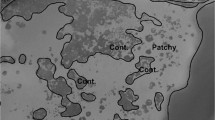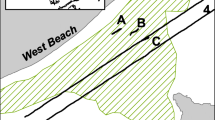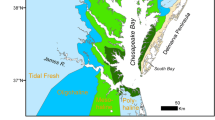Abstract
In the late 1970s and early 1980s an inventory of seagrass distribution in southeast Australia was made from multiscale aerial photographs using a simple analog mapping method, referred to here as theCamera lucida technique. Four priority estuaries were remapped in 2003, also using multi-scale aerial photographs, but using a geographic information system (GIS)-based analog mapping technique. We quantified the degree of error that arose when estimates of seagrass distribution were compared for the two techniques be ressessing. with GIS, the same aerial photographs used earlier for four estuaries: Port Hacking, Bermagui River, Merimbula Lake, and St Georges Basin.Camera lucida produced a larger estimate of total seagrass area than GIS in all four locations: 8% of total seagrass area or 12.9 ha in Port Hacking, 15% or 5 ha in Bermagui River, 20% or 38.0 ha in Merimbula Lake, and 243% or 502.2 ha in St Georges Basin. The consistent and moderate discrepancy in Port Hacking, Bermagui River, and Merimbula Lake was attributed mainly to differences betweenCamera lucida and GIS, such as the tendency ofCamera lucida to overestimate seagrass area by amalgamating disjunct seagrass patches into continuous meadows. The large discrepancy at St Georges Basin was attributed to interoperator error; i.e., the operators who mapped photographs taken in 1979 had widely differing interpretations of the aerial photographs. A 20-yr trend was calculated for each estuary using either theCamera lucida or revised GIS value as the start point. Perceived management status of the seagrass depended greatly on the initial data used. In St Georges Basin, a catastrophic decline (65%, 553.9 ha) occurred based on theCamera lucida-GIS comparison but only a small decline (14.7%, 51.8 ha) when all photos were GIS assessed, In view of the technical developments in habitat mapping, evaluation of change in seagrass abundance using remote sensing needs an assessment of intra-operator error, inter-operator error, and systemic error before maps produced by superseded technology are considered useful baselines.
Similar content being viewed by others
Literature Cited
Central Mapping Authority of New South Wales. 1975. 1: 25,000 Topographic Map of Port Hacking. Bathurst, Australia:
Ducrotoy, J. A. andS. D. Simpson. 2001. Developments in the application of photography to ecological monitoring, with reference to algal beds.Aquatic Conservation: Marine and Freshwater Ecosystems 11:123–135.
Evans, M. J. andR. J. Williams. 2001. Historical distribution of estuarine wetlands at Kurnell peninsula, Botany Bay.Wetlands 19:61–71.
Ferguson, R. L. andK. Korfmacher. 1997. Remote sensing and GIS analysis of seagrass meadows in North Carolina, USA.Aquatic Botany 58:241–258.
Finkbeiner, M., B. Stevenson, andR. Seaman. 2001. Guidance for benthic habitat mapping: An aerial photographic approach. U.S. National Oceanic and Atmospheric Administration Coastal Services Center Publication. Charleston, South Carolina.
Fitzpatrick, J. andH. Kirkman. 1995. Effects of prolonged shading stress on growth and survival of seagrass,Posidonia australis, in Jervis Bay, New South Wales, Australia.Marine Ecology Progress Series 127:279–289.
Gray, C. A., D. J. McElligot, andR. C. Chick. 1996. Intra- and inter-estuary differences in assemblages of fish associated with shallow seagrass and bare sand.Marine and Freshwater Research 47:723–735.
Green, E., C. Clark, andA. Edwards. 2000. Geometric correction of satellite and airborne imagery, p. 93–108.In A. J. Edwards (ed.), Remote Sensing Handbook for Tropical Coastal Management, Coastal Management Sourcebook 3. United Nations Educational, Scientific and Cultural Organization (UNESCO) Publishing, France.
Jordan, A., M. Lawler, and V. Halley. 2003. The application of seabed habitat mapping for multiple marine resource management in Tasmanian coastal waters, p. 157–174.In C. D. Woodroffe and R. A. Furness (eds.), Coastal GIS 2003: An Integrated Approach to Australian Coastal Issues. Wollongong Papers on Maritime Policy, No. 14. Wollongong, Australia.
Kendrick, G. A., B. J. Hegge, A. Wyllie, A. Davidson, andD. A. Lord. 2000. Changes in seagrass cover on Success and Parmelia Banks, Western Australia between 1965 and 1995.Estuarine, Coastal and Shelf Science 50:341–353.
King, R. J. 1981. Marine angiosperms: Seagrasses, p. 200–210.In M. N. Clayton and R. J. King (eds.), Marine Botary: An Australasian Perspective. Longman Cheshire, Melbourne, Australia.
King, R. J. 1988. The seagrasses of Lake Illawarra, New South Wales.Wetlands 8:21–26.
Kirkman, H. 1996. Baseline and monitoring methods for seagrass meadows.Journal of Environmental Management 47:191–201.
Kurz, R. 2000. Seagrass mapping: Accuracy issues, p. 209–215.In H. S. Greening (ed.), Seagrass Management: It’s Not Just About Nutrients! Tampa Bay Estuary Program, St. Petersburg, Florida.
Kurz, R. C., D. A. Tomasko, D. Burdick, T. F. Ries, K. Patterson, andR. Finck. 2000. Recent trends in seagrass distributions in southwest Florida coastal waters, p. 157–166.In S. A. Bortone (ed.), Seagrasses: Monitoring, Ecology, Physiology, and Management. CRC Press LLC, Boca Raton, Florida.
Larkum, A. W. D. andR. J. West. 1990. Long term changes in seagrass meadows in Botany Bay, Australia.Aquatic Botany 37:55–70.
Marshall, T. R. andP. E. Lee. 1994. Mapping aquatic macrophytes through digital image analysis of aerial photographs: An assessment.Aquatic Plant Management 32:61–66.
McNeill, S. E., D. G. Worthington, D. J. Ferrell, andJ. D. Bell. 1992. Consistently outstanding recruitment of five species of fish to a seagrass bed in Botany Bay, NSW.Australian Journal of Ecology 17:359–365.
Meehan, A. J. 2001. Conservation status of the seagrassPosidonia australis Hook. in southeastern Australia. Ph.D. Dissertation, University of Wollongong, Wollongong, Australia.
Meehan, A. J. andR. J. West. 2000. Recovery times for a damagedPosidonia australis bed in south eastern Australia.Aquatic Botany 67:161–167.
Meehan, A. J. andR. J. West. 2004. Seedling establishment and patch formation ofPosidonia australis in a southeast Australian estuary.Aquatic Botany 79:1–14.
Mount, R. 2003. The application of digital aerial photography to shallow water seabed mapping and monitoring—How deep can you see?, p. 139–156.In C. D. Woodroffe and D. A. Furness (eds.), Coastal GIS 2003: An Integrated Approach to Australian Coastal Issues. Wollongong Papers on Maritime Policy, No. 14. Wollongong, Australia.
Mumby, P. J. andE. Green. 2000. Mapping seagrass beds.In A. J. Edwards (ed.), Remote Sensing Handbook for Tropical Coastal Management. Coastal Management Sourcebook 3. United Nations Educational, Scientific and Cultural Organization (UNESCO) Publishing, France.
Orth, R. J. andK. A. Moore. 1983. Chesapeake Bay: An unprecedented decline in submerged aquatic vegetation.Science 222:51–53.
Otway, N. and W. G. McBeth. 1999. Physical effects of hauling on seagrass beds. NSW Fisheries Final Report Series No. 15. Sydney, New South Wales.
Pasqualini, V. and C. Pergent-Martini. 1996. Monitoring ofPosidonia oceanica meadows using image processing, p. 351–358.In J. Kuo, R. Phillips, D. I. Walker, and H. Kirkman (eds.), Seagrass Biology: Proceedings of an International Workshop, University of Western Australia, Rottnest Island, Western Australia.
Pasqualini, V., C. Pergent-Martini, H. Clabaut, H. Marteel, andG. Pergent. 2001. Integration of aerial remote sensing, photogrammetry and GIS technologies in seagrass mapping.Photogrammetric Engineering and Remote Sensing 67:99–105.
Patterson, K. 2001. Lake Worth Lagoon Seagrass Mapping Project Final Report. Baymont, Inc. Clearwater, Florida.
Pergent-Martini, C. and G. Pergent. 1996. Spatio-temporal dynamics ofPosidonia oceanica beds near a sewage outfall (Mediterranean-France), p. 299–306.In J. Kuo, R. Phillips, D. I. Walker, and H. Kirkman (eds.), Seagrass Biology: Proceedings of an International Workshop, University of Western Australia, Rottnest Island, Western Australia.
Robbins, B. D. 1997. Quantifying temporal change in seagrass areal coverage: The use of GIS and low resolution aerial photography.Aquatic Botany 58:259–267.
Rotherham, D. andR. J. West. 2002. Do different seagrass species support distinct fish communities in south-eastern Australia?Fisheries Management and Ecology 9:235–248.
Walker, D. I., R. J. Lukatelich, G. Bastyan, andA. J. McComb. 1989. Effect of boat moorings on seagrass beds near Perth, Western Australia.Aquatic Botony 36:69–77.
Ward, D. H., C. J. Markon, andD. C. Douglas. 1997. Distribution and stability of eelgrass beds in Izembek Lagoon, Alaska.Aquatic Botany 58:229–240.
Ward, D. H., A. Morton, T. Lee Tibbits, D. C. Douglas, andE. Carrera-Gonzales. 2003. Long-term change in eelgrass distribution at Bahia San Quintin, Baja California, Mexico, using satellite imagery.Estuaries 26:1529–1539.
West, R. J., C. A. Thorogood, T. R. Walford, andR. J. Williams. 1985. An estuarine inventory of New South Wales, Australia. Fisheries Bulletin 2, Department of Agriculture New South Wales, Australia.
Williams, R. J. andA. J. Meehan. 2004. Focusing management needs at the subcatchment level via assessments of change of cover of estuarine vegetation, Port Hacking, NSW, Australia.Wetlands Ecology and Management 12:499–518.
Source of Unpublished Materials
Fletcher, N. 1997. The seagrasses of St Georges Basin. Honours thesis (unpublished). Environmental Science, University of Wollongong, Wollongong, Australia.
Author information
Authors and Affiliations
Corresponding author
Rights and permissions
About this article
Cite this article
Meehan, A.J., Williams, R.J. & Watford, F.A. Detecting trends in seagrass abundance using aerial photograph interpretation: Problems arising with the evolution of mapping methods. Estuaries 28, 462–472 (2005). https://doi.org/10.1007/BF02693927
Received:
Revised:
Accepted:
Issue Date:
DOI: https://doi.org/10.1007/BF02693927




